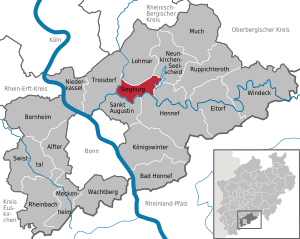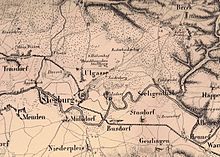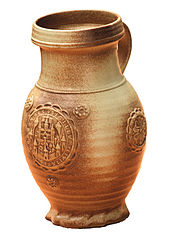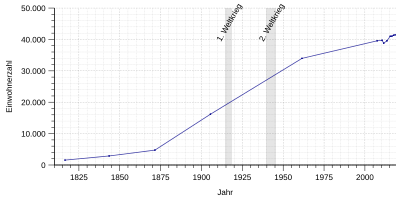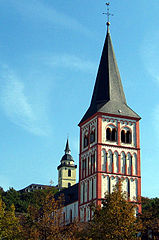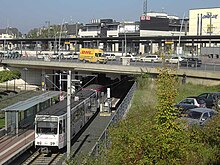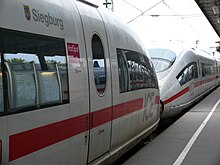Siegburg
| coat of arms | Germany map | |
|---|---|---|

|
Coordinates: 50 ° 48 ' N , 7 ° 12' E |
|
| Basic data | ||
| State : | North Rhine-Westphalia | |
| Administrative region : | Cologne | |
| Circle : | Rhein-Sieg district | |
| Height : | 60 m above sea level NHN | |
| Area : | 23.46 km 2 | |
| Residents: | 41,554 (Dec. 31, 2019) | |
| Population density : | 1771 inhabitants per km 2 | |
| Postal code : | 53721 | |
| Primaries : | 02241, 02242 | |
| License plate : | SU | |
| Community key : | 05 3 82 060 | |
| LOCODE : | DE SIG | |
| City structure: | 12 districts | |
City administration address : |
Nogenter Platz 10 53721 Siegburg |
|
| Website : | ||
| Mayor : | Franz Huhn ( CDU ) | |
| Location of the city of Siegburg in the Rhein-Sieg district | ||
Siegburg is the district town and administrative seat of the Rhein-Sieg district in the administrative district of Cologne . It is located in the south of North Rhine-Westphalia and belongs to the metropolitan regions of Rhineland and Rhine-Ruhr .
geography
Siegburg is located about 8 km east of the Rhine at the confluence of the Agger in the Sieg in the southeast corner of the Cologne Bay , bounded in the east by the heights of the Bergisches Land and in the south by the Pleiser Hügelland . Siegburg has longer borders with the neighboring towns of Troisdorf , Lohmar , Sankt Augustin and Hennef . The nearby cities of Cologne and Bonn can be reached quickly thanks to good transport connections. The highest point of the urban area is a good 220 m above sea level. NHN reached in the Braschoss district , the lowest is at just under 54 m above sea level. NHN at the Agger estuary.
Due to the small urban area, the district town is also the smallest municipality in the Rhein-Sieg district.
Waters
The city is named after the Sieg, which flows into the Rhine west of Siegburg . The tributary, the Agger , forms the dividing line to the neighboring town of Troisdorf . The Siegburger Mühlengraben branches off from the Sieg at the height of the Siegwehr, flows through the urban area and finally reunites with the Sieg. Furthermore, the Wahnbach flows from the Wahnbach dam through the area of the Siegburg district of Seligenthal . The Rothenbach, which rises in Lohmar-Heide , feeds numerous fish ponds in the large forest area (Siegburg State Forest) between the cities of Siegburg and Lohmar.
geology
Siegburg has a share in the Lower Rhine Bay , which is a tertiary geological subsidence area on the northern edge of the Rhenish Slate Mountains . In the Upper Oligocene, the sea reached into the Bonn area. The clay deposits, which later became the basis of the Siegburg ceramics trade, formed during the Oligocene . About the clays were formed lignite n seams . After the sea retreated, sands began to sediment . The terraced systems of the Rhine and its tributaries, the Sieg and the Agger, are characteristic of this area . Siegburg is known for its light gray to dark yellow tones , which give the ceramics produced from them a light color. The Aulgasse takes its name from the pottery.
Mining
Mining was also carried out in the relatively small urban area of Siegburg . The Ziethen mine was located below the Wahnbach dam between Seligenthal and Weingartsgasse . Lead and copper ores must have been mined here as early as the 12th century. In 1854 the mine was put back into operation.
The mining took place here to a depth of 70 meters. The dewatering in the shaft turned out to be extremely difficult. In 1878 the operation was stopped because the thickness of the ores decreased with increasing depth. The pit was re-examined from 1923 to 1927, but no more mining took place. On site you can still find a large overgrown heap and some iron bars that protrude from the ground.
To the east of Schneffelrath were the Pliny and Franz ore mines. The ore mines of Pliny were only mined for a short time around 1860.
nature
Natural monuments
- The landmark of Siegburg is the Michaelsberg , which is crowned by the former Benedictine Abbey of St. Michael. Geologically it is an extinct volcano .
- Five English oaks in the city forest
- A common beech north-east of Gut Umschoss , an eight-stemmed tree
- European beech in the Kaldau municipal forest. It is the tallest beech in the Rhein-Sieg district.
Nature reserves
- Wetland in the Hufwald, a swamp area below Siegburg- Kaldauen between the Sieg altar and the Haus zur Mühlen.
- Victory arms above the Siegwehr between the Wolsberge and the A 3 motorway bridge.
- Trerichsweiher , a pond created in the 16th century. Fish farming was carried out here until the end of 1970. Parts of the pond were filled in by the construction of the bypass road (B 56).
- Wahner Heide and parts of the Aggerau in the Rhein-Sieg district.
history


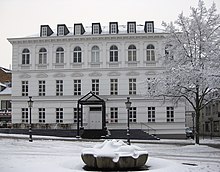
Early days
The oldest human traces found so far come from the Neolithic Age (approx. 3000 - approx. 1800 BC). There are hatchets, blades and scrapers made of stone and pottery shards. The oldest settlements in the area of the city of Siegburg date back to between 1000 and 500 BC. Dated. Finds are documented on the Brückberg and the Seidenberg. The Franconian conquest reached the Siegburg area around 500 AD . Shortly before the birth of Christ, the Romans came to the Rhine. For a few hundred years the Rhine became the border between the Roman Empire on the left bank and the Celtic and Germanic tribes on the right. Given the proximity to the Roman settlements in Cologne and Bonn, it can be assumed that there was brisk border trade.
middle Ages
Since the 9th century there was a castle on the Michaelsberg, which was owned by the Ezzonen . In 1060 the Count Palatine Heinrich I of Lorraine was expelled by Archbishop Anno II of Cologne . As a result, Michaelsberg Abbey, a Benedictine abbey , was founded by the Archbishop in 1064 . The abbot of the monastery was also the ruler of the settlement at the foot of the mountain. Four years later, in 1069, Siegburg received market , customs and minting rights from King Heinrich IV in 1069 and, before 1182, city rights . As a supporter of the reform efforts within the church at that time, the Archbishop Anno II made the abbey a center of the renewal of Benedictine monasticism, for which the expression "Siegburg Reform" was coined. Anno was in 1075 at the Abbey buried ( Anno Shrine ) and the grateful Abbey reached in 1183 his canonization , which attracted many pilgrims.
As building material for numerous buildings of that time, e.g. B. St. Servatius (second building 1169), the tuff basalt mined in the Wolsberge was used , also called "Wolsdorfer Brocken". The city wall, which was not dismantled until 1865, also dates from this time.
In today's Seligenthal district , Count Heinrich III. von Sayn and his wife Mechthild von Landberg established a Franciscan monastery . The monastery church was completed in 1256 in the Rhenish transition style and is today the oldest preserved Franciscan church north of the Alps. In 1285 a contract was signed between Siegburg and Cologne, which gave the citizens of the other city the same rights as their own citizens. At the same time, the choir of the parish church was rebuilt based on the high Gothic model of Cologne Cathedral.
The political life of medieval Siegburg was shaped by three institutions. The abbot was the head of the abbey and the city. A Vogt was responsible for jurisdiction and military protection. This office was exercised by the Counts of Berg from the middle of the 12th century . The third and weakest institution was the city council, representing the citizens.
Siegburg has been a pottery town since around 1000 . The development of the pottery trade began much earlier than in the equally well-known Rhenish "pottery town" Frechen . The pottery was in the suburb of Aulgasse . From around 1300 Siegburg experienced a boom in pottery. The potters produce sintered Siegburg stoneware . From around 1500 Siegburg experienced a renewed boom in pottery. The Siegburg potters succeeded in adding artistic decorations to the pottery. The fast ones come from Siegburg . Before and after 1600 a large part of the potters left Siegburg. Some settled in the Kannebäckerland in the Westerwald and the pottery trade in Siegburg lost its importance.
15th to 18th century
In 1403 the Siegburg abbot Pilgram vom Drachenfels promised Johann II von Loen to take over the Siegburg umbrella bailiff . This led to the Siegburg War between the abbey and the townspeople, and the townspeople besieged the abbey with the later Duke Adolf von Berg , the son of the previous bailiff. The abbey was badly damaged but not taken; the city was set on fire. The city and the abbey agreed to leave the bailiff rights to the Lords of Berg.
In 1588, during the Truchsessian War, there was an unsuccessful siege of Siegburg by Spanish troops. In 1614/1615 Siegburg was besieged again by Brandenburg- state troops in the course of the Jülich-Klevischen succession dispute . Almost 20 years later, Siegburg was conquered in October 1632, during the Thirty Years' War, by General Baudissin's Swedish troops , who held them for three years. From 1636 to 1638 Siegburg experienced the persecution of witches by the witch commissioners Franz Buirmann and Kaspar Lieblar (Liblar). This was facilitated by the absence of the abbot, who had fled to Cologne before the war. 37 people (32 women and five men) were victims of the witch trials . There are still 19 complete witch trial protocols as well as process fragments in the North Rhine-Westphalian main state archive in Düsseldorf and the city archive in Siegburg. The numerous armed conflicts of those times caused an economic decline.
In 1670, Duke von Berg's troops destroyed large parts of the medieval fortifications on the Michaelsberg.
In 1676 Siegburg came as a sub-office to the Duchy of Berg , which was ruled from Düsseldorf . From 1741 to 1742 the city was finally occupied by French troops. In the course of the 18th century, several fires destroyed the old abbey complex. As a result, the abbey was largely given its present appearance through new buildings in the Baroque style.
19th century
In 1803 the French came again as occupiers. The abbey was secularized and abolished after almost 750 years of existence. After Napoleon's defeat and the Congress of Vienna, the Rhineland and with it Siegburg became part of the Kingdom of Prussia. With the establishment of the Rhine Province , Siegburg became the district town of the newly formed Siegburg District in 1816 , which was renamed Siegkreis in 1825 after merging with the Uckerath District in 1825 . In 1825 the First Rhenish Insane Asylum was established in the buildings of the former abbey and existed there until 1878.
In 1828 Siegburg had 3,576 inhabitants, 110 of them Protestant and 162 Jewish. In addition to Troisdorf and Wolsdorf, the parish also included the Flögerhof and Ulrodderhof ( Uhlrather Hof ) farms . In 1829 viticulture was stopped on Michaelsberg.
In 1840 industrialization began in the district town with the relocation of the calico factory Rolffs & Co. from Cologne to Siegburg. In the course of industrialization, Siegburg developed into an important transport hub and industrial location in the Bergisches Land . In 1859 Siegburg received a railway connection, in the wake of which two large royal Prussian armaments factories with up to 5,000 employees were settled.
Around 1865 the dilapidated city gates were demolished. In 1886 the royal Prussian penal institution in Siegburg was opened, today's correctional institution Siegburg . In 1892 the state armaments factories settled in Siegburg, the Royal Bullet Factory Brückberg and the Royal Fireworks Laboratory, in which up to 20,000 people worked during the First World War .
On April 1, 1899, the community of Wolsdorf was incorporated into Siegburg as part of a regional reform .
20th century
20th century (until 1945)
The good industrial development of the city caused the population of Siegburg to skyrocket to around 20,000 by the end of the First World War. However, the end of the war also meant the closure of the armaments factories, resulting in high unemployment.
As everywhere in the Rhineland, the Catholic Center Party dominated the Weimar Republic . When the NSDAP came to power in 1933, synchronization began in Siegburg as well . In 1933 an SS man was shot on the night of February 15 while an SS troop tried to storm the Volkshaus . Despite a lack of evidence, six men were later sentenced to eight to twelve years in prison. In March / April, numerous political opponents (communists, social democrats, trade unionists, etc.) from Siegburg and the surrounding area were transferred to the Siegburg prison for protective custody . In the course of the November pogrom in 1938, the synagogue in Holzgasse was destroyed. Until 1942 many Siegburg Jews, whose community size was around 400 people, were u. a. Deported via the Much camp to the concentration camps in the east for extermination. Moritz Heymann from Siegburg was able to escape to Argentina in 1940 on an adventurous escape via Russia, Japan, the USA and Venezuela. He saved the Torah from the former Siegburg synagogue; this is now in Israel.
1937 Siegburg was one of the first German highways, the A 3 connected. The 30 km section between the Cologne-Mülheim motorway junction and Siegburg was opened to traffic on December 17, 1937 after around three years of construction. A year later, on December 15, 1938, the 12 km section followed up to the Siebengebirge junction and on September 20, 1939 another 30 km to Dierdorf.
From 1939 until the end of the war, several thousand foreign forced laborers were employed in large and small companies in Siegburg. More than 400 of them were killed. In 1941 the monks of Siegburg Abbey had to be classified as "hostile to the Reich" by the Gestapo. The abbey was used as a military hospital and anti-aircraft observation post until the end of the war.
On December 28, 1944, 1,500 bombs were dropped on Siegburg in a bombing raid, killing 66 people and injuring hundreds. Michaelsberg Abbey was almost completely destroyed in this air raid. On March 3, 1945, Siegburg were bombed again; this time 3,000 bombs were dropped, killing 35 residents and damaging around 1,000 buildings. On March 9 and 10, 1945, Wolsdorf was bombed and killed over 100 people. On April 10, 1945 Siegburg was occupied by parts of the 97th Infantry Division of the US Army after weeks of fighting. The Americans appointed the German-American Eugen Vogel from Siegburg as mayor.
20th century (from 1945)
The reconstruction of the city and abbey from 1945 onwards was determined by the scarcity economy. The abbot and convent returned to Siegburg to initiate reconstruction with the population. In July 1947, the citizens and monks celebrated the 1400th birthday of St. Benedict in the ruins of the abbey. In 1953 the rebuilt abbey church was consecrated. The repair work continued until 1967.
In the course of the post-war period, the Prussian industrial city became an administrative, service and trading center. Important companies were the Pringswerke and the Siegwerke.
From 1957 the guard battalion at the Federal Ministry of Defense and the staff music corps of the Federal Armed Forces were stationed in the Brückberg barracks in Siegburg. The guard battalion came to Berlin in the course of reunification, but the staff music corps remained in Siegburg.
On August 1, 1969, Siegburg became the district town of the new Rhein-Sieg district . Parts of the municipalities Buisdorf, Hennef (Sieg) and Lauthausen were incorporated. From 1974 to 1978 a new district building was built for the Rhein-Sieg district in Siegburg .
21st century
In 2003, the integration of Siegburg performed on the ICE - Cologne-Frankfurt , accompanied by a new station building and the redesign of the city center between the station and market.
In 2017, the Catholic Social Institute (KSI) of the Archdiocese of Cologne moved into the building of the former abbey on Michaelsberg.
Demographics
Population development
- 1816: 1.557
- 1843: 2.877
- 1871: 4,748
- 1905: 16.190
- 1961: 33.974
- 2007: 39,563
- 2010: 39,746
- 2011: 38,809
- 2013: 39,563
- 2015: 41,016
- 2016: 41,034
- 2017: 41,326
- 2018: 41,463
- 2019: 43,333
(References: information after 2011 from IT-NRW after updating the population based on the census of May 9, 2011. Population from 1905 together with Wolsdorf and 1961 together with Wolsdorf and Braschoß.)
Population structure
As of April 1, 2019, Siegburg has 43,333 inhabitants and is thus far above that of IT-NRW. 6383 of them are foreigners (residents without German citizenship ).
The quota for women is 21,843 (50.4%) compared to 21,489 men (49.6%).
religion
The following religious groups exist in Siegburg:
- Siegburg Buddhist Group ( Diamond Way Buddhism, Karma Kagyu Line)
- Christadelphian parish
- Christian communities: see list of churches and chapels in Siegburg
- Islamic community: DITIB Mosque Siegburg
- Jehovah's Witness
Denomination statistics
According to the 2011 census , 21.0% of the population in 2011 were Protestant , 41.9% were mostly Roman Catholic and 37.1% were non-denominational , belonged to another religious community or did not provide any information. The number of Protestants and Catholics has fallen since then, and at 47%, people who do not belong to any legally or corporately constituted religious community make up a majority of the population. Currently (as of March 31, 2020) of the 43,478 inhabitants, 7,797 (17.9%) are Protestants, 15,000 (34.5%) are Roman Catholics and 47.6% are non-denominational or belong to another religious community.
The denomination on October 1, 2019 was:
| religion | Male | Female | total |
| Old Catholic | 5 | 10 | 15th |
| Evangelical | 3,474 | 4,257 | 7,731 |
| Evangelical Lutheran | 57 | 96 | 153 |
| Evangelical Reformed | 5 | 9 | 14th |
| Evangelical Free Church | 23 | 40 | 63 |
| French reformed | 0 | 1 | 1 |
| Israelite (Jewish) | 1 | 1 | 2 |
| Roman Catholic | 7,050 | 8,141 | 15.191 |
| Russian Orthodox | 28 | 33 | 61 |
| Without information, without a community, …* | 10,648 | 9,116 | 19,765 |
| Others | 255 | 225 | 480 |
* This also includes those with no religious affiliation and those religions that are not subject to church tax deduction.
politics
City council
The city council is the municipal representative of the city of Siegburg. The citizens decide on the composition every five years. The last election took place on May 25, 2014.
City directors / mayors
| City Directors | Honorary Mayor | mayor |
|---|---|---|
|
|
|
coat of arms
The blue escutcheon contains the gold nimbly archangel Michael , wings in silver, a red cloak, in the hands a golden scepter and a blue orb with a golden cross. Michael stands on a mountain as a growing figure and points to the origin and location of the city, the monastery on the Michaelsberg. The image on the mountain shows a striding, red, blue armored lion and thus represents the otherwise standing Bergisch lion and indicates the earlier political affiliation of Siegburg to the Duchy of Berg . The Counts of Berg were bailiffs of Michaelsberg Abbey.
Finances
Siegburg is the highly indebted (per capita) municipality in North Rhine-Westphalia (as of December 31, 2014). For every inhabitant there was a mathematical 9,566.86 euros in city debt.
Town twinning
Siegburg has five city partnerships:
-
 Nogent-sur-Marne in France, since 1964
Nogent-sur-Marne in France, since 1964 -
 Guarda , the highest episcopal city in northeastern Portugal on the mountain border with Spain,
Guarda , the highest episcopal city in northeastern Portugal on the mountain border with Spain, -
 Bunzlau (Boleslawiec) associated in today Poland Lower Silesia, in 1992
Bunzlau (Boleslawiec) associated in today Poland Lower Silesia, in 1992 -
 Selçuk , a place southeast of Izmir on the west coast of Asia Minor / Turkish, since 1993
Selçuk , a place southeast of Izmir on the west coast of Asia Minor / Turkish, since 1993 -
 Orestiada in Thrace / Greece, since 1994
Orestiada in Thrace / Greece, since 1994
The two Siegburg twin cities of Nogent-sur-Marne and Bolesławiec have also been part of a partnership since 2002.
Sponsorships
The three sponsorships of the city of Siegburg are a specialty :
- Guard battalion and music corps of the Bundeswehr
- The guard battalion at the Federal Ministry of Defense and the Bundeswehr music corps have been stationed in Siegburg since 1957 . In 1988 the garrison town sponsored the two units in order to express its close ties to the soldiers who were known for their honorary service to the Federal President and at state visits and receptions . The cordial bond between the city and the guard battalion or music corps continues, even if the soldiers of the guard battalion are now mainly on duty in Berlin.
- Minesweeper "Wega"
- On the initiative of the "Marinekameradschaft Siegburg 1913", the city took over the sponsorship of the fast minesweeper "Wega" in 1965 . After the "Wega" was decommissioned in 1988, the successor boat was named "Siegburg". Crews and officers of the "Siegburg" come to Siegburg just as regularly as citizens' trips to the boat take place in its home port, Kiel .
- ICE
- On July 22, 2003, the 403016/403516 cars were named Siegburg ( # 76 ) at the Siegburg / Bonn train station .
Culture and sights
Siegburg is home to the Siegburg studio stage , the Rhein-Sieg Volkstheater and the Rhein-Sieg-Halle, a multifunctional complex that opened in September 2006 and can accommodate up to 2,000 spectators. The museums include the Siegburg City Museum , the Siegwerk Museum in the Torhaus and the Abbey Museum in Michaelsberg Abbey.
Regular events
- Medieval market at Christmas
- Siegburg Literature Weeks (November) / Awarding of the Rheinischer Literaturpreis Siegburg
- Ceramic market (second Sunday in July)
- Humperdinck Music Festival (July)
- Siegburg organ cycle
- Siegburg summer rendezvous (May to September)
- Siegburg City Festival (on the last weekend in August)
- Siegburg triathlon every two years
- Siegburg Rose Monday Parade
- Siegtal Pur / Car-free Siegtal - once a year at the beginning of July, a bicycle adventure day
- Siegburg Wine Festival (beginning of May),
Attractions
- Benedictine Abbey of St. Michael : The castle complex, built around 800 on what was then known as the Sigeberg , initially served as the seat of the respective count who just ruled the Auelgau . Around 1060, the Archbishop of Cologne , Anno II, won the castle of Count Palatine Heinrich and founded a Benedictine abbey in 1064 . In 1803 the abbey was secularized . Today's abbey is a baroque complex from the 17th / 18th centuries. Century. The grave of Annos II († 1075) and the Anno shrine from 1183 are located in the abbey church .
- The parish church of St. Servatius was built before the abbey was founded and in the 12th / 13th centuries. Century expanded to a two-aisled gallery basilica . It houses a treasury with the late Romanesque-Gothic Siegburg church treasure, which can be visited. The St. Servatius Church is also known for the large organ made by the Klais organ manufacture and the International Siegburg Organ Cycle that takes place there.
- The Haus zum Winter , the former rectory of the Servatius Church, was built between 1220 and 1230 and is the oldest, at least partially preserved residential building in Siegburg. It is located on the upper market (Griesgasse 2).
- The Hexenturm , located in Bergstrasse, is part of the city wall and served as a watchtower in the form of a half-tower. However, it did not get its name until the 19th century, when it was named in the novel by Wilhelm Herchenbach: Master Hansen, the executioner of Siegburg. shows up.
- The former royal Prussian armory (Zeughausstrasse) gained importance when irregulars tried to storm it in 1849. The Engelbert Humperdinck music workshop is housed in the armory, which is now a listed building.
- Seligenthal Monastery Church (Sankt Antonius )
- Victory column on the upper market
Culinary specialties
- Siegburg Abbey Liqueur , made according to an old monastery recipe.
- Michel and the naturally cloudy Siegburger , beers from the Siegburger Brauhaus .
Economy and Infrastructure
General
After 2000, many large-scale projects were realized. The building of the former main post office was demolished. An office and commercial building of the Kreissparkasse Köln , the S-Carré, was built in its place. The former Neue Poststrasse, the public transport transit route from the train station towards the western city center, became the extension of the pedestrian zone . The former street An der Stadtmauer has completely disappeared; there is now a footpath there. After a construction period that was considerably longer than planned, the Siegburg / Bonn ICE train station on the Cologne – Frankfurt route was also completed in 2004.
traffic
In Siegburg in is public transport (PT) of the tariff of the transport association Rhein-Sieg (VRS) valid.
Light rail
The city is connected to Bonn by the Siegburger Bahn (tram line 66), which runs every 10 minutes over the Kennedy Bridge and the Konrad-Adenauer Bridge in Bonn to Bad Honnef during rush hour . Line 66 also connects Siegburg with Sankt Augustin and Königswinter . Line 67 only runs on school days, twice in the morning and twice in the afternoon, with the difference that line 67 runs from Siegburg train station to Bad Godesberg train station .
Railway (long-distance and local rail passenger transport)
Since 2003 Siegburg is the ICE - high-speed line Cologne-Rhine / Main tethered. Siegburg received a new station building with surrounding shops especially for this purpose. The station was named Siegburg / Bonn , as the ICE stop is connected to Bonn via Stadtwerke Bonn's tram line 66 . Siegburg is also mentioned in the list of ICE with city names . Furthermore, the city is on the win path Cologne - Siegen and is of regional express trains on the line RE 9 operated. The S-Bahn lines S 12 ( Düren - Cologne - Hennef - Au (Sieg) ) and S 19 also stop here.
Road traffic
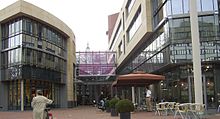
Siegburg is on the A 560 (to Bonn and Hennef) and A 3 (Frankfurt – Cologne) motorways as well as on the B 8 and B 56 federal highways .
On January 1, 2018, 25,091 motor vehicles were registered in Siegburg , including 21,675 cars.
From 2004 to 2010, the combined trackless train "Michel-Express", the pedestrian area (Holzgasse, market, train station) with the Siegburg Abbey .
Established businesses
- The Siegwerk AG, one of the world's largest printing ink manufacturer, has been based since 1840 in Siegburg.
- HIT Handelsgruppe GmbH & Co. KG
- From January 1937 to December 1957 the cantulia accordions were manufactured in Siegburg .
- Until 2009: Seat of the Federal Joint Committee (G-BA)
- The Institute for the Hospital Remuneration System (InEK GmbH)
media
Newspapers
- Kölner Stadt-Anzeiger , edition Rhein-Sieg
- Kölnische Rundschau , edition Rhein-Sieg
- General-Anzeiger , edition Rhein-Sieg on the right bank of the Rhine
- Extra sheet, Siegburg edition
Radio and television
education
- Schauspielschule Siegburg (vocational school for performing stage arts)
- Vocational college of the Rhein-Sieg district
- Adult Education Center Rhein-Sieg
- Engelbert Humperdinck Music School
- Technical school for social pedagogy
High schools
- Siegburg Alleestraße high school
- Anno high school
- Wirtschaftsgymnasium Siegburg-Zange
Comprehensive schools
- Comprehensive school in the Neuenhof school center
- Free Christian Comprehensive School Rhein Sieg in Siegburg
Realschulen
- Alexander von Humboldt Realschule Siegburg
Secondary schools
- Neuenhof school center (dissolved)
Elementary schools
- Adolf Kolping School Brückberg
- Primary school for special needs Brückberg
- Elementary schools Deichhaus , Hans-Alfred-Keller-Schule, Humperdinckstraße, Nord, Siegburg-Kaldauen, Siegburg-Stallberg , Wolsdorf, elementary school Zange
- Free Christian Elementary School
Judiciary
In addition to the Siegburg correctional facility, the
- District court Siegburg , responsible for the right bank of the Rhine-Sieg district with the exception of the municipalities of Windeck ( district court Waldbröl ), Königswinter and Bad Honnef ( district court Königswinter ) and that
- Siegburg Labor Court, responsible for the right bank of the Rhein-Sieg district and the Oberberg district with the exception of the municipalities of Hückeswagen and Radevormwald .
The Siegburg correctional facility hit the headlines nationwide in 2006 when a brutal case of abuse became known in which a 20-year-old was tortured to death by three inmates.
Healthcare
The Helios-Klinikum Siegburg is an acute hospital with 361 beds which are available in the specialist clinics of cardiac surgery and cardiology, radiology, internal medicine, general and visceral surgery, vascular surgery, orthopedics and trauma surgery. Anesthesia and intensive care medicine, pain therapy as well as the ear, nose and throat medicine department and a vascular surgery focus complete the range of medical services.
Sports
- Tennis : The tennis club Tennisclub an der Sieg e. V. trains and plays on five clay courts in the east of the district town, directly on the dead arm of victory .
- The largest sports club in Siegburg with a wide range of sports is the Siegburger Turnverein e. V.
- Handball : The HSG Sieg emerged from a cooperation between FC Hennef 05 e. V. and the Siegburger Turnverein e. V. and starts from the C-youth. However, the youngsters below still play under the name of the Siegburg gymnastics club.
- Tennis : The Siegburg Tennis Club Blau Weiss e. V. maintains eight clay courts
- Billard : The Siegburger Billard-Club e. V. exists since 1950 and used to play up to the state level.
- Rowing : The Siegburger Ruderverein 1910 e. V. offers rowing and popular sports.
- Chess : The 1919 Siegburg e. V. plays with three teams in the Siegburg hospital.
- Boxing : The Siegburger Box-Club 1921 e. V. is one of the oldest boxing clubs in Germany. Hein Mück is a member .
- Soccer : The Siegburger Sportverein 1904 e. V. is one of the oldest clubs in Siegburg. This is where Wolfgang Overath's career began.
- Table tennis : The TTC BW Viktoria Siegburg 1930/39 e. V. offers table tennis in four teams.
- Triathlon : The SV Hellas Siegburg e. V. exists since 1923 and offers swimming , water polo and triathlon.
- Athletics : The TV Kaldauen 1906 e. V. offers volleyball , gymnastics , table tennis , various courses and athletics ( LAZ Puma Rhein-Sieg ).
Personalities
Honorary citizen
- 1900: Peter Brühl (secret medical council)
- 1909: Franz vorm Walde (retired royal high school director, privy councilor)
- 1917: Hubert Bamberg (pastor)
- 1919: Jean Fußhöller (city council member)
- 1946: Kaspar Heppekausen (honorary dean)
- 1952: Paul Hubert Kraemer (pastor)
- 1955: Ildefons Schulte Strathaus (abbot)
- 1964: Alfred Keller (entrepreneur)
- 1975: Eleonore Keller (entrepreneur)
- 1975: Ewald Klett (Mayor)
- 1983: Helena Schmitz (entrepreneur)
- 1985: Hans Alfred Keller (entrepreneur)
- 1998: Placidus Mittler (former abbot)
- 2002: Veronika Keller (entrepreneur) (born March 11, 1927; † May 16, 2017)
- 2003: Wolfgang Overath (soccer player)
sons and daughters of the town
- Johann Heinrich Fischer (1735 – after 1789), painter, created a. a. Painting of the old Anno shrine
- Charles Wimar (1828–1862), painter, emigrated to the USA in 1843, known for his depictions of Native Americans
- Joseph Hermann Mohr (1834–1892), musicologist, wrote numerous hymns
- Engelbert Humperdinck (1854–1921), composer
- Adelheid Wette (1858–1916), writer
- Johann Albert Sawinsky (1884–1960), entrepreneur
- Reinhold Eichacker (1886–1931), lawyer and writer
- Leo Fusshöller (1889–1963), poet, non-fiction author and educator
- Torsten Gebhard (1909–1994), folklorist, art historian and monument conservator
- Reinold Hagen (1913–1990), entrepreneur and pioneer in the plastics industry
- Hans Josef Mundt (1914–2002), writer and editor
- Rudolf Lucas (1916–1980), lawyer and politician, government director in Hesse
- Rudolf Schmitz (1918–1992), pharmacy historian and university professor
- Norbert Hagen (1920–2013), entrepreneur and pioneer in the plastics industry
- Ilse Hollweg (1922–1990), opera singer
- Ruth Rehmann (1922–2016), writer
- Norbert Herkenrath (1929–1997), Roman Catholic priest, development worker
- Ernst H. Hilbich (* 1931), actor and cabaret artist
- Jörg Cossardt (* 1935), actor and voice actor
- Hans Karl Weitzel (* 1936), doctor, gynecologist and obstetrician
- Hein Mück (* 1941), boxer
- Wolfgang Overath (* 1943), soccer player, former president of 1. FC Köln, member of the German national soccer team, soccer world champion 1974, honorary citizen of Siegburg since 2003
- Achim Kuczmann (* 1954), former coach of the German national basketball team and Bundesliga coach
- Bert Marco Schuldes (1955–2012), naturopath and author
- Peter Kurth (* 1960), CDU politician, Berlin Finance Senator from 1999 to 2001, 2009 candidate for the position of Mayor of Cologne
- Katja Bellinghausen (* 1961), actress
- Wolfgang Seidenberg (* 1962), actor
- Björn Franken (* 1979), member of the state parliament
- Anke Johannsen (* 1981), singer, pianist and songwriter
- Maxim (* 1982), singer
- Rafael Calman (* 1982), jazz musician
- Axel Bellinghausen (* 1983), soccer player
- Patricia Hanebeck (* 1986), soccer player from FCR 2001 Duisburg
- Moritz auf der Heide (* 1987), long-distance and ultra runner
- Simone Gorholt (* 1989), young actress ("Marienhof")
- Maximilian Holst (* 1989), handball player (TV Großwallstadt)
- Sarah Kim Gries (* 1990), young actress ("Die Wilden Kerle")
- Joy-Lance Mickels (* 1994), soccer player
- Joy-Slayd Mickels (* 1994), football player
- Sertan Yegenoglu (* 1995), football player
- Leroy-Jacques Mickels (born 1995), football player
People associated with the city
- Anno II of Cologne (also: Hanno von Köln, Hanno II. Etc.), (around 1010-1075), 1056-1075 Archbishop of Cologne, saint of the Catholic Church
- Johann Lair (1476–1554), also called John Siberch (derived from his place of residence in Siegburg), founded the university print shop in Cambridge (England) in 1520
- Ignaz Pfefferkorn (1726–1798), Jesuit, missionary and naturalist
- Maximilian Jacobi (1775–1858), doctor and founding director of the first Rhenish provincial mental hospital
- Friedrich Hoffmann (1820–1863), psychiatrist, director of the Siegburg sanatorium
- Josef Dietzgen (1828–1888), working-class philosopher, journalist and tanner
- Ludwig Hugo Ripping (1837–1898), psychiatrist, director of the lunatic asylum in Siegburg
- Hermann Knackfuß (1848–1915), academy professor and painter, attended the Siegburg high school
- Josef Müller (1875–1945), folklorist and editor of the Rhenish Dictionary, graduated from high school in Siegburg in 1895
- Willi Schultz (1892–1972), school teacher and collector of Pomeranian folk songs and folk dances, lived in Siegburg from 1947 after the expulsion from Pomerania
- Lotte Betke (1905–2008), writer and actress
- Mauritius Mittler (1921–2013), Benedictine monk as well as historian, author and editor
- Placidus Mittler (1928–2016), Benedictine monk and old abbot of the St. Michael Abbey
- Ulf Merbold (* 1941), physicist, astronaut, head of the European Astronaut Center of ESA in Cologne, lived in Siegburg
- Matthäa Held (1942–2018), religious, 1973–2008 director of the Pauline von Mallinckrodt children's and youth home
- Miklos Muranyi (* 1943), an orientalist living in Siegburg
- Hanna Jansen (* 1946), author of books for children and young people, lived in Siegburg for over twenty years
- Günter Ollenschläger (* 1951), grew up in Troisdorf , science journalist, lecturer at the University Hospital Cologne and from 1995 to 2014 head of the Medical Center for Quality in Medicine, graduated from the Siegburg Anno-Gymnasium in 1969
- Hermann Josef Hack (* 1956), artist and founder of the Global Brainstorming Project
- Michael Opielka (* 1956), social scientist living in Siegburg
- Mathias Wünsche (* 1957), author, lyricist and composer living in Siegburg
- Tom Buhrow (* 1958), graduated from the Siegburger Anno-Gymnasium in 1978, former moderator of the daily topics in the ARD, director of the WDR
- Michael Boddenberg (* 1959), Hessian finance minister, passed his Abitur in 1978 in Siegburg
- Markus Maria Profitlich (* 1960), comedian, attended the Haufeld secondary school in Siegburg and was group leader in the YMCA there
- Karl Jüsten (* 1961), a Roman Catholic clergyman (prelate) who grew up in Siegburg, since 2000 head of the commissariat of the German bishops - Catholic office in Berlin
- Elisabeth Winkelmeier-Becker (* 1962), member of the Bundestag for Siegburg and Parliamentary State Secretary
- Georg Bitter (* 1968), lawyer and professor at the University of Mannheim , graduated from the Siegburger Anno-Gymnasium in 1988
- Ross Antony (* 1974), musical performer who lives in Siegburg
- Melanie Amann (* 1978), lawyer and journalist who grew up in Siegburg
- René Böttcher (* 1979), director of the drama school in Siegburg and the studio stage in Siegburg since 2004
- Dominique Kusche (* 1990), actress Lindenstrasse who lives in Siegburg
Others
In the 1958 papal election, the two Siegburg doctors Alfred Möhlenbruch and Norbert Zylka were walled in during the conclave in the Vatican. They accompanied Cardinal Tien Ken-sin , who had recently been seriously injured in a car accident on the B 56.
literature
- Andrea Korte-Böger: The witch trials in Siegburg (1636-1638) . Siegburger Blätter, History and Stories from Siegburg, No. 6, April 2005 (with life pictures of the 19 people executed in Siegburg).
- Andrea Korte-Böger (Ed.): Protocols of the Siegburger Schöffengericht (Volume 1: Court actions from the years 1541 and completed in 1547 on Monday post Oculi) , with the collaboration of Elisabeth Sommer and W. Günter Henseler (Edition), Rheinlandia, Siegburg, ISBN 978-3-935005-10-4 .
- Andrea Korte-Böger (Ed.): Protocols of the Siegburger Schöffengericht (Volume 2: Court actions from 1530 and completed in 1538 on the Saturday after Epiphany Domini) , with the collaboration of Elisabeth Sommer and W. Günter Henseler (Edition), Rheinlandia, Siegburg, ISBN 978-3-935005-61-6 .
- Andrea Korte-Böger (Ed.): Protocols of the Siegburger Schöffengericht (Volume 3: Court actions from the year 1547 up to and including 1554 on June 4th) , with the collaboration of Manuela Kerlin and W. Günter Henseler (Edition), ISBN 978-3- 935005-91-3 .
- Andrea Korte-Böger and W. Günter Henseler (eds.): Protocols of the Siegburger Schöffengericht (Volume 4: Court actions from the year 1554 to and completed 1561 on April 8th) , Rheinlanda, Siegburg, ISBN 978-3-938535-43-1 .
- Andrea Korte-Böger (Eds.) And W. Günter Henseler: Protocols of the Siegburger Schöffengericht (Volume 5: Court actions from 1554 and completed 1561–1566) , Rheinlandia, Siegburg 2010, ISBN 978-3-938535-62-2 .
- Peter H. Krause: Besieged, conquered, plundered, Siegburg wartime from 1583 to 1714. Verlag Franz Schmitt, Siegburg 1998, ISBN 3-87710-185-2 .
- Siegburger Blätter (No. 34 published in 2003)
- Publications of the history and antiquity association for Siegburg and the Rhein-Sieg-Kreis:
- Vol. 1 - Wilgrand: Contributions to the history of the city of Siegburg.
- Vol. 2 - Maria Geimer: Memorandum for the incorporation of part of the Braschoss community into the city of Siegburg.
- Vol. 4 - Josef Semmler : The monastery reform of Siegburg.
- Vol. 6 - Mauritius Mittler (OSB): Report on the translation of the Holy Archbishop Anno and Annonian Miracle Reports.
- Land under. The flood catastrophe 1909 (Siegburger Blätter Volume 24) , Siegburg 2009.
- Matthias Bertram: … in another country. History, life and paths of life of Jews in the Rhineland. ISBN 978-3-95631-333-2 , (including Jewish families and their descendants from Siegburg (Heymann, Walter, Löwenstein, Wallerstein and others))
Web links
- Website of the city of Siegburg
- Website of the history and antiquity association for Siegburg and the Rhein-Sieg-Kreis e. V.
- Website of the Siegburg City Museum
Individual evidence
- ↑ Population of the municipalities of North Rhine-Westphalia on December 31, 2019 - update of the population based on the census of May 9, 2011. State Office for Information and Technology North Rhine-Westphalia (IT.NRW), accessed on June 17, 2020 . ( Help on this )
- ^ District town of Siegburg - information (PDF), p. 25
- ↑ Natural monuments in the Rhein-Sieg district ( Memento from August 6, 2011 in the Internet Archive )
- ↑ a b c d e f g h i j k l m n o p City of Siegburg: Siegburg history . Ed .: Tourist Information Siegburg. Siegburg 2017.
- ^ Theodor Joseph Lacomblet : Archive for the History of the Lower Rhine Vol. I, No. 483, Düsseldorf 1840
- ↑ Salina Braun: As for the main cause of his mental illness, ... self-defilement. Disease attributions and treatment practices in the Irren-Heil-Anstalt Siegburg (1825–1878). The case of Georg G. In: Würzburg medical history reports . No. 25 , 2006, pp. 43–61 , here: p. 47 f .
- ^ Friedrich von Restorff: Topographical-Statistical Description of the Royal Prussian Rhine Provinces. Nicolaische Buchhandlung, Berlin / Stettin 1830, p. 289 ( digitized version ).
- ^ Synagogue with a women's bath in Siegburg | Object view. Retrieved July 7, 2019 .
- ↑ Reiner Burger: Siegburg. Sign of the times . Frankfurter Allgemeine Zeitung, November 11, 2010
- ^ Ulrich Hofmann: The liberation and capture of Siegburg. Compilation of the course of events based mainly on American eyewitness accounts. Accessed December 31, 2019 .
- ↑ Martin Bünermann: The communities of the first reorganization program in North Rhine-Westphalia . Deutscher Gemeindeverlag, Cologne 1970, p. 85 .
- ↑ Census results from 1816 to 1970 of the cities and municipalities . Contributions to the statistics of the Rhein-Sieg-Kreis, vol. 17 / Siegburg 1980, p. 148.
- ↑ Population statistics (PDF; 61 kB) as of April 1, 2019.
- ^ Siegburg Religion , 2011 census
- ^ Siegburg religious affiliation , accessed on June 13, 2020
- ↑ a b Religious affiliations on October 1, 2019 (PDF) City of Siegburg, accessed on December 11, 2019 .
- ^ District town of Siegburg. Council election - overall result. May 25, 2014. Retrieved October 25, 2014 .
- ↑ Loans, cash advances and securities debts of the municipalities and municipal associations of North Rhine-Westphalia on December 31, 2014. (PDF) Information and Technology North Rhine-Westphalia - Press Office -, June 3, 2015, p. 7 , accessed on June 8, 2015 (ranking shown in the embedded Excel file).
- ^ Report on the Siegburg town partnerships.
- ^ Siegburg sponsorships
- ↑ Siegtal Pur - Car-free Siegtal. Retrieved November 2, 2016 .
- ↑ Nadine Quadt: Siegburg makes the Hexenturm accessible again. In: General-Anzeiger (Bonn). May 24, 2018, accessed June 11, 2018 (article with picture).
- ↑ Klaus Elsen: Liqueur is preserved In: General-Anzeiger (Bonn). June 21, 2011.
- ↑ Sieburger Abbey Brewery. In: siegburger-brauhaus.de.
- ↑ Stadtwerke Bonn 2008 mini timetable for line 67.
- ↑ Mobility in North Rhine-Westphalia - data and facts 2018/2019. In: Road traffic. Ministry of Building, Housing, Urban Development and Transport of the State of North Rhine-Westphalia, p. 66 (PDF; 14.2 MB, holdings on January 1, 2018).
- ↑ Susanne Haase-Mühlbauer: The Siegburg accordion factory Cantulia once supplied the world market. In: General-Anzeiger (Bonn) , November 4, 2013, Siegburg
- ↑ G-BA moves into new office in Berlin - new building completed on schedule. Federal Joint Committee, January 4, 2010, accessed on June 22, 2019 .
- ^ JVA Siegburg: Torture break only for the "sports show". In: The time. October 4, 2007, accessed March 25, 2015 .
- ↑ helios clinics , accessed on April 16, 2016.
- ^ Anna Maria Beekes: Papal election 1958: Two doctors from Siegburg were there. Generalanzeiger Bonn, March 8, 2013, accessed on April 10, 2013 .

